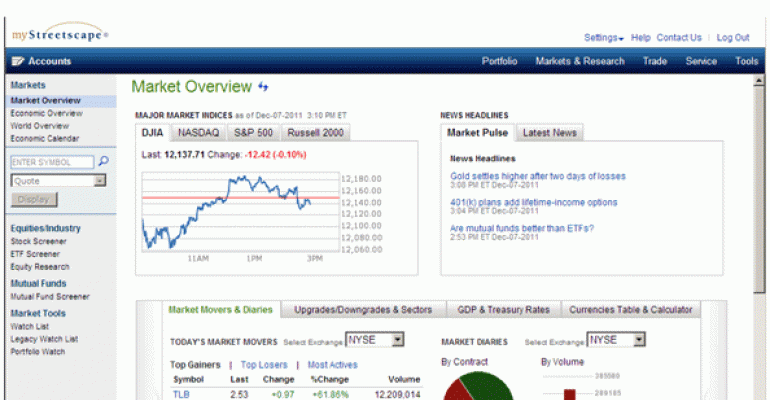Financial advisors who custody and clear with Fidelity Investments’ National Financial expect their telephones to start ringing more often in the weeks and months ahead. Many of their clients will soon be able to access their accounts via smartphones, and a good portion of those clients, equipped with more ready access to their accounts, will likely find they have additional questions for their brokers about why their investments are doing better or worse.
It’s part of the first major upgrade in 10 years for Fidelity’s platform for retail investors, called myStreetscape (not to be confused with Streetscape, the platform that’s used only by financial advisors at Fidelity’s 300 broker/dealer clients and was itself upgraded earlier this year). Richard Hart III, senior vice president and head of platform solutions, concedes it’s been an “embarrassingly” long time in coming. “We hadn’t touched it, and the feedback from the clients was, ‘You need to touch it,’ ” he says.
Fidelity’s new myStreetscape is available on the Web, offers more functions (streaming price quotes and snapshot reports on stocks), improved navigation (carousels and tabs) and expanded features (15 new pages on market data and research offerings). The Web-based myStreetscape is in pilot use now and will roll out in the coming months. Advisors can brand their clients’ myStreetscape page with their own practice name if they like. The Streetscape and myStreetscape platforms enjoy similar designs so advisors can follow their clients during telephone conversations about how their investment portfolios are doing. Hart says Fidelity will tinker more with the system next year as feedback rolls in from users.
Fidelity also says that in mid-January investors will be able to access their accounts via iPhone, Droid and Blackberry apps. The apps will allow clients to trade, provided the clients’ advisors want them to be able to do that. Hart says the reason for advisor override on trading by clients is to avoid the possibility of skewing the portfolio strategy with sales or purchases that don’t fit. In some cases, advisors may be able to set up a trading account that’s separate from the portion of the portfolio the advisor is managing.
More Apps
National Financial will also launch a new iPad app for broker/dealer advisors in the first quarter of 2012; iPad use for investors will follow later in the year. And an iPad app for RIAs will be launched in January. Tablet access is important to investors, according to a recent Spectrem Group survey that found investors prefer tablets to smartphones for a number of financial activities.
Fidelity is, to a certain extent, playing catch up with the competition. Wirehouses and even smaller custodians are already offering these services. (Trust Company of America, the Colorado-based RIA custodian, this fall launched its new Liberty platform that provides client access via tablets across all operating platforms, something that Fidelity doesn’t plan to have available until next year.) Consumer demand is also driving the rollout. Fidelity, citing Forrester Research, says 11 percent of adults online with investment accounts are “mobile investors,” a figure that’s up 37 percent over the preceding six months. Two-thirds of mobile investors are using their devices to check account balances, while half obtain stock prices and other market data and 25 percent trade online.
A little knowledge is said to be a dangerous thing. Will investors, equipped with readily accessible data updated in real time, be deluging their advisors with questions and concerns about what they’re seeing? Hart expects it’s so, but he’s not worried. “Putting more data in the hands of clients is a good thing, and if it drives more conversations, then we can have a deeper relationship. That’s what we as advisors want,” he says.








